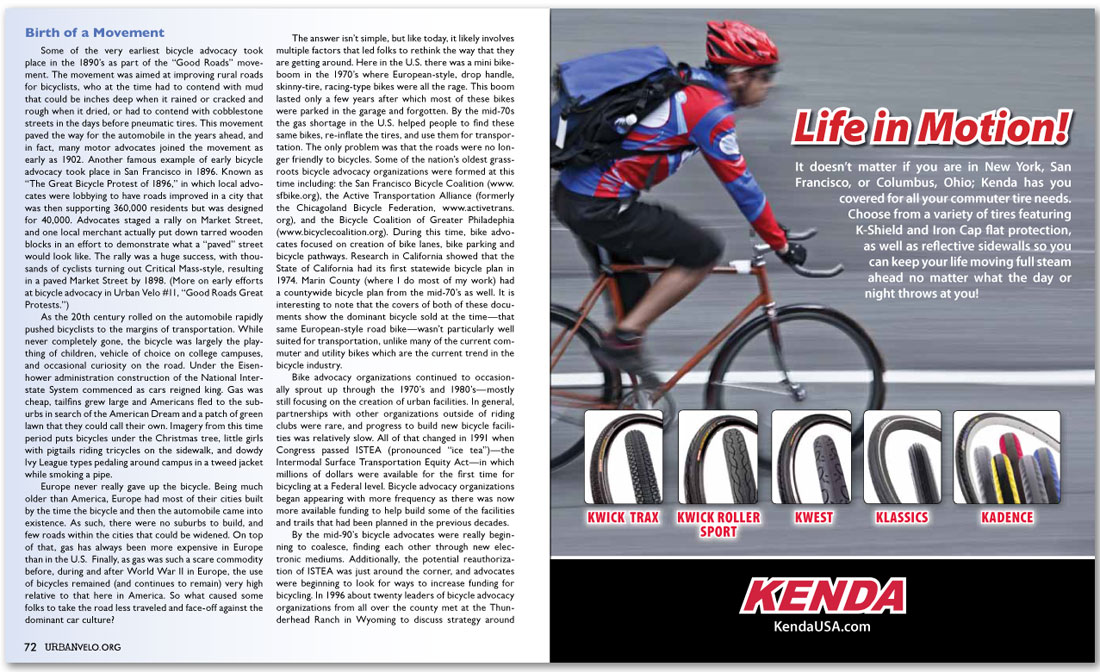


Birth of a Movement
Some of the very earliest bicycle advocacy took place in the 1890’s as part of the “Good Roads” movement. The movement was aimed at improving rural roads for bicyclists, who at the time had to contend with mud that could be inches deep when it rained or cracked and rough when it dried, or had to contend with cobblestone streets in the days before pneumatic tires. This movement paved the way for the automobile in the years ahead, and in fact, many motor advocates joined the movement as early as 1902. Another famous example of early bicycle advocacy took place in San Francisco in 1896. Known as “The Great Bicycle Protest of 1896,” in which local advocates were lobbying to have roads improved in a city that was then supporting 360,000 residents but was designed for 40,000. Advocates staged a rally on Market Street, and one local merchant actually put down tarred wooden blocks in an effort to demonstrate what a “paved” street would look like. The rally was a huge success, with thousands of cyclists turning out Critical Mass-style, resulting in a paved Market Street by 1898. (More on early efforts at bicycle advocacy in Urban Velo #11, “Good Roads Great Protests.”)
As the 20th century rolled on the automobile rapidly pushed bicyclists to the margins of transportation. While never completely gone, the bicycle was largely the plaything of children, vehicle of choice on college campuses, and occasional curiosity on the road. Under the Eisenhower administration construction of the National Interstate System commenced as cars reigned king. Gas was cheap, tailfins grew large and Americans fled to the suburbs in search of the American Dream and a patch of green lawn that they could call their own. Imagery from this time period puts bicycles under the Christmas tree, little girls with pigtails riding tricycles on the sidewalk, and dowdy Ivy League types pedaling around campus in a tweed jacket while smoking a pipe.
Europe never really gave up the bicycle. Being much older than America, Europe had most of their cities built by the time the bicycle and then the automobile came into existence. As such, there were no suburbs to build, and few roads within the cities that could be widened. On top of that, gas has always been more expensive in Europe than in the U.S. Finally, as gas was such a scare commodity before, during and after World War II in Europe, the use of bicycles remained (and continues to remain) very high relative to that here in America. So what caused some folks to take the road less traveled and face-off against the dominant car culture?
The answer isn’t simple, but like today, it likely involves multiple factors that led folks to rethink the way that they are getting around. Here in the U.S. there was a mini bike-boom in the 1970’s where European-style, drop handle, skinny-tire, racing-type bikes were all the rage. This boom lasted only a few years after which most of these bikes were parked in the garage and forgotten. By the mid-70s the gas shortage in the U.S. helped people to find these same bikes, re-inflate the tires, and use them for transportation. The only problem was that the roads were no longer friendly to bicycles. Some of the nation’s oldest grassroots bicycle advocacy organizations were formed at this time including: the San Francisco Bicycle Coalition (www.sfbike.org), the Active Transportation Alliance (formerly the Chicagoland Bicycle Federation, www.activetrans.org), and the Bicycle Coalition of Greater Philadephia (www.bicyclecoalition.org). During this time, bike advocates focused on creation of bike lanes, bike parking and bicycle pathways. Research in California showed that the State of California had its first statewide bicycle plan in 1974. Marin County (where I do most of my work) had a countywide bicycle plan from the mid-70’s as well. It is interesting to note that the covers of both of these documents show the dominant bicycle sold at the time—that same European-style road bike—wasn’t particularly well suited for transportation, unlike many of the current commuter and utility bikes which are the current trend in the bicycle industry.
Bike advocacy organizations continued to occasionally sprout up through the 1970’s and 1980’s—mostly still focusing on the creation of urban facilities. In general, partnerships with other organizations outside of riding clubs were rare, and progress to build new bicycle facilities was relatively slow. All of that changed in 1991 when Congress passed ISTEA (pronounced “ice tea”)—the Intermodal Surface Transportation Equity Act—in which millions of dollars were available for the first time for bicycling at a Federal level. Bicycle advocacy organizations began appearing with more frequency as there was now more available funding to help build some of the facilities and trails that had been planned in the previous decades.
By the mid-90’s bicycle advocates were really beginning to coalesce, finding each other through new electronic mediums. Additionally, the potential reauthorization of ISTEA was just around the corner, and advocates were beginning to look for ways to increase funding for bicycling. In 1996 about twenty leaders of bicycle advocacy organizations from all over the county met at the Thunderhead Ranch in Wyoming to discuss strategy around